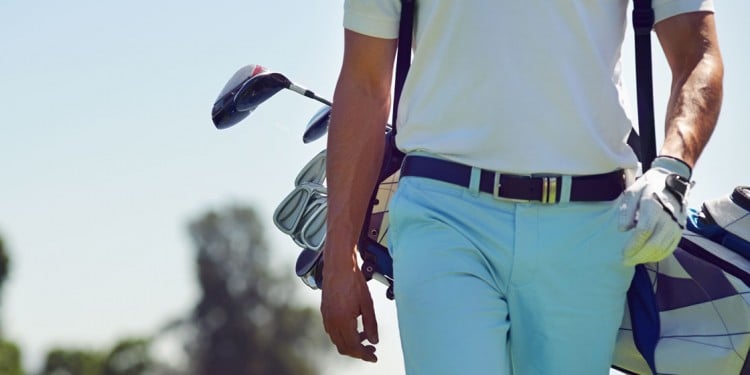By: Joshua J Stone, MA, ATC, NASM-CPT, CES, PES
Injuries in golf occur as they do during participation in any athletic orientated activity. Research indicates injuries in golf relate to functions of age, skill level, and frequency of play. According to Gosheger et al., over 80% of golf-related injuries are due to overuse (1). The most common injury experienced by professional golfers is low-back dysfunction.
Low-back golf injuries can be chronic in nature due to poor swing mechanics, poor conditioning, or overuse. Research has shown that golfers who have low-back pain demonstrate a decrease in range of motion for hip internal rotation on the lead leg, decreased lumbar extension, decreased activation and/or timing of the abdominal obliques, spinal erectors, and knee extensors (2-4). A common low back disorder of golfer’s is sacroiliac joint (SIJ) dysfunction.
Can Golfers Play With Sacrum and Illium (SI) Joint Pain?
As loads are transferred between the trunk and legs, the flat surfaces of the sacrum and ilium make the SIJ subject to considerable forces. If SIJ stability is not maintained, loads cannot be transferred efficiently between the trunk and legs, which may result in abnormal loading joint tissue and the development of pain (5).
The transverse abdominis and internal oblique play a significant role in resisting shear loads across the SIJ and maintaining stability (5). Proper execution of an abdominal drawing-in maneuver during performance should enhance the stability of the SIJ joint and allow for the most efficient transfer of forces between the trunk and legs. Utilizing assessment techniques of the NASM Corrective Exercise Specialization to identify human movement dysfunction and compensatory compensations will pave the way for developing a prevention program.
Exercise is believed to be a vital component in preventing the occurrence of low-back pain and injury. What is unclear, however, is the type of exercises that should be performed as part of a low-back pain prevention and rehabilitation program. Liddle, et al. concluded that strengthening exercises targeting the lumbar spine, lower limbs, and abdominal muscles were the predominant exercises performed in successful exercise programs that decreased pain and improved function (6). Hayden, et al systematic review concluded that programs including strengthening or trunk stabilizing exercises were most effective.
A separate meta-analysis, (7) indicated that the most effective programs consist of a supervised, individually designed set of stretching and strengthening exercises. In agreement with the observations and recommendations from the scientific literature, the best approach to developing a low-back injury prevention program includes a variety of inhibitory and lengthening exercises aimed at improving flexibility of tight and overactive muscles, isolated strengthening exercises for weak and inhibited muscles, and improving neuromuscular control through integrated exercise is recommended.
Inhibit: 1-2 times daily for 30-90 seconds at each body part
- TFL / IT Band
- Adductors
- Piriformis
Lengthen: 1-2 times daily, for 30 seconds (60 seconds for elderly clients) per body part
- Kneeling Hip Flexor Stretch
- Standing Adductor Stretch
- Supine Ball Piriformis Stretch
Activate: 1-2 sets per body part, 10-15 reps, slow and controlled tempo
- Side-lying Hip abduction
- Quadruped, opposite arm/leg raise
- Stability Ball Bridge
Integrate: 1-2 sets, 10-15 reps, slow and controlled tempo
- Lateral Tube Walking (progress to #2 if to0 easy)
- Multi-planar step-up, curl, to press (progress to #3 if too easy)
- Single leg squat to PNF pattern
References:
- Gosheger G, Liem D, Ludwig K, Greshake O, Winkelmann W. Injuries and overuse syndromes in golf.Am J Sports Med. 2003;31(3):438-443.
- Horton JF, Lindsay DM, Macintosh BR. Abdominal muscle activation of elite male golfers with chronic low back pain. Med Sci Sports Exerc. 2001;33(10):1647-1654.
- Lindsay D, Horton J. Comparison of spine motion in elite golfers with and without low back pain. J Sports Sci. 2002;20(8):599-605.
- Vad VB, Bhat AL, Basrai D, Gebeh A, Aspergren DD, Andrews JR. Low back pain in professional golfers: The role of associated hip and low back range-of-motion deficits. Am J Sports Med. 2004;32(2):494-497.
- Snijders CJ, Ribbers MT, de Bakker HV, Stoeckart R, Stam HJ. EMG recordings of abdominal and back muscles in various standing postures: validation of a biomechanical model on sacroiliac joint stability. J Electromyogr Kinesiol. 1998; 8:205-14.
- Liddle SD, Baxter GD, Gracey JH. Exercise and chronic low back pain: what works? Pain. 2004; 107:176-90.
- Hayden JA, van Tulder MW, Malmivaara A, Koes BW. Exercise therapy for treatment of non-specific low back pain. Cochrane Database Syst Rev. 2005:CD000335.












